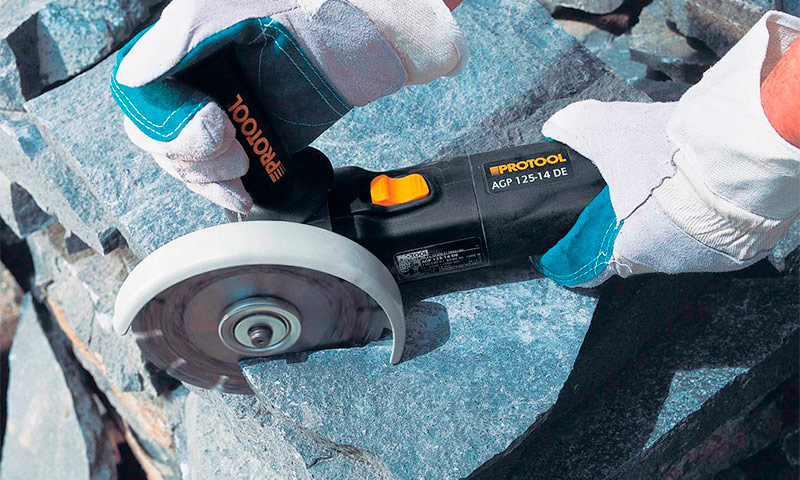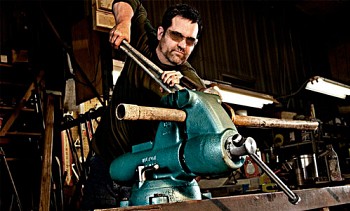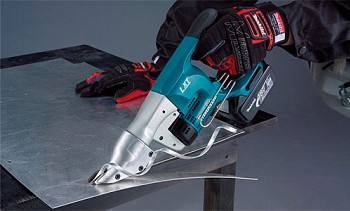Diamond cutting discs, or, as they are also called, diamond wheels, have a number of advantages over conventional abrasive counterparts. They have significantly higher rates in terms of resource, cutting accuracy and productivity. Next, we will consider how to choose a diamond disc for the grinder, what types of discs exist and what is their advantage.

Content:
Introducing Diamond Cutting Discs
Anhydrous cutting wheels with diamond cutting edges were first created at the design bureau of the Japanese company Sankyo Diamond Tools, a structural division of Hitachi Corporation.
Many technologies were used for the first time, so the circles were not reliable enough and quickly failed. For example, diamonds and the cutting part were fastened to a steel base using high temperature brazing. In the process, when a large friction force occurred, the metal was heated, the solder melted and the working part simply fell off. With water cooling, such circles worked more or less tolerably, but with dry friction, their resource was small.
The fact is that diamond does not cut the material, but abrades it into dust, large friction forces are accompanied by rapid heating - the heat does not have time to be removed along the body of the circle, in addition, despite the presence of special slots, the circle deforms when heated. Changes in shape are minor and do not threaten destruction, but they have a negative effect on the strength of the joint.

Sankyo Diamond engineers also proposed other solutions - sintering the working part and base under high pressure. Such a connection is more durable and can withstand significantly higher temperatures. Thus, it was possible to create segmented and solid disks resistant to heating and deformation. The technology is still used.
The second solution is laser welding at the molecular level. Using this technology, only circles of a segmented type are produced. Both discs are almost identical in strength and reliability, although many professionals believe that laser-made discs are better.
The principle of operation of the cutting diamond blade
Most diamond blades are used on angle grinders with speeds of up to 12,000 rpm. The maximum number of revolutions that the best circles can withstand is 13,900 rpm, but there are not too many tools that can develop them when cutting.
Only the diamond itself is in contact with the surface to be treated - it protrudes above the surface of the rim and during rotation abrades the material into fine dust. The multilayer structure of the cutting edge ensures constant readiness of the disk for work - diamonds that are abrasive or fly out of the nest are replaced by others located in the lower layer of the rim.
Excess heat is removed through the drive body, but, nevertheless, it heats up to sufficiently high temperatures, which requires compliance with certain safety rules for dry cutting.
The longevity of the wheel and its effectiveness depend on the size of the diamonds. Large ones provide work efficiency, but wear out quickly, small ones cut very accurately, but slower, their service life is 25-30% longer than that of an instrument with large fractions of crystals.

Cutting diamond disc design
Structurally, a diamond disk is a steel circle with a cutting part and slots over the entire area, which contribute to heat dissipation and reduce deformation stresses. Diamonds are interspersed throughout the rim of the disk. They are inserted into the rim from alloys of nickel, zinc, cobalt and tin. With a linear speed of movement of up to 80 m / s and tremendous friction forces, the fastening must be extremely durable, which is achieved using special technologies.
To ensure the holding of the cutting part under heavy loads, they can be fixed using laser welding, sintering, galvanic method or soldering. Soldering is only used on waterjet cutting discs.

Depending on the method of fixing the diamond, the purpose of the disk is determined. Galvanized diamonds are designed to work with soft types of natural stone, processed by laser welding and sintering, especially segmented - for all types of solid materials in a dry and "wet" way.
The holes and slots are strictly symmetrical, and the mass of diamonds is balanced in diametrically opposite directions. This eliminates vibration and “runout” of the disc and ensures uniform cutting. But you can use circles for dry cutting only to perform a straight cut - with a curved path, the disk can not only lose diamonds, but also collapse. This type of tool is very sensitive to lateral loads.

1. Damping slots. 2. The cutting layer. 3. Landing hole. 4. Steel disk.
Varieties of Diamond Blades
Diamond cutting discs have certain differences in design and manufacturing technology.
Types of diamond blades by structure
By structure, dry cutting discs are divided into:
- solid;
- segmented
- turbo;
- turbo-segmented.
Solid diamond blades. Equipped with a continuous cutting tape running around a circle in which artificial diamonds are interspersed in several rows. For cutting ceramics and other materials where the accuracy of the cut is the main parameter, circles with a solid edge are preferable.

Segmented diamond blades.The segmented ones are divided by radial cuts into several working sections of the same size, they are more resistant to mechanical and thermal loads and are used more often than solid ones, although they are somewhat more expensive. They are more productive than solid, but the cut after them is not so accurate. They are best used for rough cutting of concrete structures.

Diamond wheels turbo.Turbo discs are distinguished by the presence of an oblique (and not only) notch on the sides of the rim. It slightly increases the mechanical strength of the wheel and significantly enhances the intensity of heat dissipation, which allows to accelerate cutting from 50 to 100%. Like segmented discs, turbos are suitable for fast cutting of any mineral materials with a wide range of hardness - from sandstone to concrete and granite.

Turbo-segmented diamond blades.Even more productive are circles divided into segments with a “turbo” side notch. They are characterized by high performance and versatility.

The difference in disc location of diamonds
Artificial diamonds are fixed in the working rim in a certain order. There are circles with their uniform distribution when the same number of crystals is in any of the selected units of length or segment.
But there are circles in which diamonds are placed with a certain period (the so-called sandwich). They are more productive, providing less effort on the tool, more efficient cooling and even distribution of effort.

Diamond blades for dry and wet cutting
According to the cutting method, diamond blades are divided into circles for dry and wet cutting.The former provide accurate cutting and are more “clean” in operation, but require the use of dust suction devices - when cutting, very small particles of solid materials are formed that irritate the eyes and respiratory tract. Water-cooled wheels operate with a constant flow of fluid that binds and flushes dust, but they can not always be used. This is due to some bulkiness of the hydraulic system and the formation of sagging.
Dry cutting wheels can be used in water-cooled machines, but wet cutting discs cannot be used without cooling - they overheat and quickly collapse.
How to choose a diamond disc for a grinder
When selecting a diamond disk, you must pay attention to the type of material for which the disk is intended, its size, landing diameter and speed of rotation of the disk.
Material to be worked with
Most diamond wheels are designed to work with non-metallic materials. Most often they are used for cutting concrete, ceramics, glass, brick and asphalt. But there are a number of discs designed for cutting metals of various hardness. When buying, you should remember that different types of diamond blades are designed to work with various materials. There are discs designed to work with concrete, ceramic tiles, marble, granite, sandstone, stone and asphalt.
There is a certain rule for choosing a disk - for soft materials circles with a hard strapping of diamonds are selected, and for hard materials - with a soft one. This is determined by the degree of wear of artificial diamonds located on the rim of the circle.
When cutting hard materials, they wear out faster and the next ones come out of their place from a fairly soft cutting strip. Soft materials, on the other hand, have little effect on the diamond; it should remain in its place for as long as possible, which provides a solid substance in which the mineral is interspersed.
In addition, different artificial diamonds are used for different circles.
Two types of diamonds are produced industrially:
- Monocrystalline, representing one spatial structure of the correct form;
- Polycrystalline, consisting of several smaller monocrystals firmly connected among themselves.
The former are very durable and are used for cutting hard materials and metals, the latter can be destroyed upon contact with them, therefore they are used on cheaper tools designed for relatively soft materials.

Sizes of diamond blades
The maximum cutting depth and, in some cases, the speed of work depend on the size of the disk. The main diameters are 115, 125, 180 and 230 mm, which corresponds to abrasive wheels for angle grinders of the most common grades. On sale, you can also find diamond discs with a diameter of 150, 300 and more millimeters. Large diameters are installed on powerful cutting machines - gas cutters, stationary type cutting machines, etc.
The most common mounting holes for discs can be 22.2 mm or 25.4 mm. Only buy a disc the size your tool is designed for.
Never install a large disc on a grinder that is designed to work with a smaller disc, having previously removed the protective cover. This is very dangerous, because if you destroy a metal disk, you can cause fatal damage to your health. If you have such ideas, then find on the Internet a photo of the consequences of working with a diamond disk without a protective cover and you will forever feel like working without protection.
Disk rotation speed
Also on disks the maximum rotation speed and linear speed are indicated. If the capabilities of your tool exceed the characteristics of the disk, then you can not put it - centrifugal forces will simply tear it apart.
Problems encountered in the process and methods of solving
1. As already mentioned, diamond blades are designed exclusively for straight cuts.The cutting speed and feed force must be adjusted so that the working area does not overheat. At rim temperatures above 700 0With artificial diamonds, they are graphitized and lose a significant percentage of strength.
You can increase the disk resource in a simple way - periodically remove it from the cut without turning off the angle grinder motor. The incoming air stream cools the disk and relieves thermal stress between the central part and the working area.
Another way to increase disk life is to avoid cutting too deep in one pass. It is better to sequentially walk along one trajectory several times. This will slightly increase the operating time, but the tool life will become twice as long.

2. One of the main problems encountered in the work is the rapid wear of the working area. First of all, this is due to the wrong choice of tool, too high feed (clamp) speed, or to the condition of the angle grinder drive. If beating occurs in it, then the life of the disk is sharply reduced, in some cases, with especially large amplitudes of oscillations, it can be destroyed, which is very dangerous.
If the side of the blade wears below the cutting edge, it means that the feed has been violated or a drive defect has occurred that creates a side runout.

3. When segments become dull, it is necessary to replace the disc - it is not suitable for this material. If the disk is selected correctly, but still there is such a picture - it is necessary to cool the disk more often. It overheats due to too much load. The same reasons lead to a discoloration of the base of the disc - a bluish tint appears on the steel circle.
4. If cracks appear on the disc, replace it immediately. The disk cracks in case of non-compliance with the material or too intense work. Often, these defects appear after jamming in the cut, or distortion during operation. To avoid trouble, inspect the drive before operation and periodically during operation, stopping the tool.
5. It is not allowed to work with a diamond disk if the angle grinder or other tool is defective - lateral and radial runouts, uneven rotation, uncontrolled increase or decrease in rotation speed occur. In this case, the tool must be returned for repair or buy a new one.
To increase the life of a diamond blade, you need to follow a number of simple rules:
- use circles of large diameter, thus reducing the load on the crystals;
- A angle grinder or other tool must be selected as powerfully as possible, this ensures stability of revolutions;
- choose the right disc in accordance with the material;
- Do not exceed the permissible speed.
When working with diamond blades, gloves, goggles and respirators are required.



